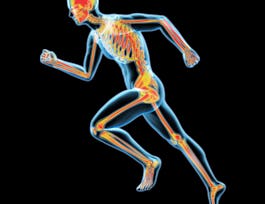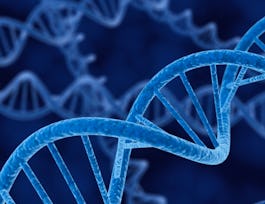You have all heard about the DNA double helix and genes. Many of you know that mutations occur randomly, that the DNA sequence is read by successive groups of three bases (the codons), that many genes encode enzymes, and that gene expression can be regulated.


Classical papers in molecular genetics
Taught in English
Some content may not be translated
24,937 already enrolled
(237 reviews)
Details to know

Add to your LinkedIn profile
12 quizzes
See how employees at top companies are mastering in-demand skills


Earn a career certificate
Add this credential to your LinkedIn profile, resume, or CV
Share it on social media and in your performance review

There are 12 modules in this course
At the dawn of genetics, in the work of Mendel and Morgan, there was a complete void between the genes and the characters they determine.During the first week, we will discuss the relationship between genes and enzymes. We will start with the description of alkaptonuria by Garrod, in 1902, which he called a few years later an inborn error of metabolism. This was the first documented example of a human recessive trait, the first association of a human condition with Mendel’s principles and the first link between a gene and an enzyme. This work and that of Cuénot on mice fur color were essentially forgotten in the biology community in the following decades.After working with great difficulty on the enzymatic cascade that leads to the formation of the pigmented eye of fruit flies, Beadle and Tatum founded the field of biochemical genetics by isolating conditional mutants that affect the synthesis of vitamins and amino acids. This was first done with a mold, and then extended to bacteria. These experiments lead to the “one gene, one enzyme” hypothesis. While the hypothesis is now proven in many cases, the exceptions, including multigene enzymes, structural and enzymatic RNAs have expanded the concept rather than invalidating it.
What's included
7 videos2 readings1 quiz
Most people believed that genes must be made of proteins because nucleic acids were considered too simple to carry genetic information. Avery worked all his life on Pneumococcus and bacterial pneumonia. Griffith showed that transformation of a non-virulent strain can be achieved in mice by coinjection of heat-killed virulent bacteria. Avery’s lab managed to obtain transformation in the test tube, but it took many years to establish a reliable assay and finally to purify the molecule responsible for this effect, which turned out to be DNA. Although this work was well known, most scientists were not convinced of the general implication of this phenomenon. Furthermore, many biochemists believed that even the purified DNA was contaminated with a protein. Finally, transformation was a very inefficient process and the mechanism of transformation remained mysterious for many years. The work of Hershey and Chase finally convinced the scientific community that genes are made of DNA. We now realize that exchange of DNA by transformation is very common, and participates to the horizontal transfer of DNA between at least bacterial species, and was a considerable accelerator of evolution
What's included
7 videos2 readings1 quiz
The origin of mutations was a field of heavy discussions between proponents of Darwinism and those of Lamarckism. The major issue was to define an experimental approach that would unambiguously discriminate between mutations occurring at random and mutations caused by the selective agent used to reveal their existence. In the case of bacteria that became resistant to the lytic action of a bacteriophage, the hypotheses were labeled “mutation to immunity” versus “acquired immunity”. Luria and Delbrück realized that the variations observed in the number of resistant bacteria in different parallel cultures were intimately linked to the mutation hypothesis. This exceptional collaboration between a theoretical physicist and a bacteriologist is a perfect example of interdisciplinary work, while these two “enemy aliens” were working in the USA. At that time, it was not even clear that bacteria had genes and most bacteriology work was only descriptive. The use of a quantitative approach allowed the authors to settle the question. The fluctuation test is a very powerful tool to calculate mutation rates. Soon after, Newcombe did a simple but elegant experiment to demonstrate that the increased number of resistant bacteria that are detected upon clonal expansion reflects both the amplification of preexisting mutants and the continuous occurrence of new mutations.
What's included
4 videos2 readings1 quiz
When DNA was found to be the genetic material, it was not known how this molecule could carry information. The structure of DNA thus became of critical importance. The available X-ray images obtained by M. Wilkins and R. Franklin only yielded a rough picture, and even R. Franklin, who had the clearest diffraction data, could not decide whether the molecules contained two or three strands. Both Pauling and Watson and Crick used molecular models with known inter-nuclear distances (bond length) and bond angles to predict a structure. While the model of Pauling was hardly realistic, since it used the protonated form of the phosphate, the model proposed by Watson and Crick proposed that DNA consists of a pair of DNA strands. Furthermore, it indicated that any nucleotide sequence could be accommodated in the structure. The only central biological issue that was addressed in the first paper was replication, and the famous sentence was really nothing more than a priority claim. Much more biology was discussed in the second paper. It was assumed that base pairing is sufficient to account for the fidelity of replication. The importance of DNA polymerase in replication fidelity was first demonstrated by Speyer.
What's included
5 videos2 readings1 quiz
Before Benzer’s experiments, most genetic mapping required a screening of all the progeny of a cross to calculate the recombination frequencies. The power of the rII system of phage T4 resides in the facts that many independent mutants can be identified by scoring plaque morphology on the permissive host strain, and that only wild type recombinants will grow on the restrictive host strain. This, together with the very high recombination of T4 DNA, allows the detection of recombination between mutations affecting adjacent nucleotides. The cis-trans complementation test showed that the rII locus consists of two genes. Using more than 100 deletion mutants, which do not revert to wild type, Benzer first demonstrated that the topology of DNA is linear. Using these deletions, he was able to carve the rIIA and rIIB genes in 47 segments. A very simple and rapid recombination test allowed him to map thousands of point mutants, both independent and mutagen-induced, in individual segments. This map was perfectly congruent with maps laboriously constructed by classical recombination tests. The topography of the map was strikingly non-random, with sites that are 100 times more likely to mutate than others and are called hot spots. The spectrum of sites detected after mutagenesis was strikingly different. It is now known that most of the spontaneous rII mutants are frame-shift, i.e. addition or deletion of one or a few base pairs that disrupt the translation of the mRNA into protein. In contrast, most mutagens used in this work induce base substitutions that do not usually arrest translation. Now that the sequence of the rII locus is known, the saturation of the map is such that there are about one mutation every 8 nucleotides.
What's included
6 videos2 readings1 quiz
Benzer and Champe studied the properties of deletions that cover the boundary between rIIA and rIIB. As expected, most of them cannot provide either function during infection of a non-permissive strain. One deletion however was highly unusual and was still able to provide rIIB function even though it lacks 10% of the rIIB sites. This deletion was instrumental in confirming the general nature of the genetic code proposed by Crick et al. In the discussion, the authors evoke the notion of bi-functional enzymes such as tryptophane synthase. In bacteria, the two catalytic activities are performed by individual proteins encoded by adjacent enzymes. In eucaryotes, both reactions are performed by a single protein: the product of the first reaction does not diffuse out but is “funneled” into the second active site. This is just one exception to the one gene one enzyme model discussed in the first session. Crick et al. start their paper by presenting the evidence that the code must be non-overlapping. One evidence, provided by Brenner, is the founding work of what will become bioinformatics. Starting with a single rIIB frameshift mutation, now known to involve the addition of a single base pair that displaces the reading frame of the mRNA, they isolate many intragenic suppressor mutations that restore rIIB function. The original mutation is given a + sign, and its suppressors a - sign. They then isolate suppressors of these suppressors that are themselves + mutants. All tested combinations of two + and two – mutations lack rIIB function. Most combinations of a + and a – mutations have rIIB function; the other combinations are proposed to generate a stop codon between the two frame shifts. Finally, a number of triple mutants were shown to have rIIB function. They use the unusual deletion that fuses the two rII genes to demonstrate that frameshift mutation located in the rIIA portion of the fused gene abolish its rIIB function. The simplest interpretation is that + mutants have one more (or one less) base pair and that – mutants have one less (or one more) base pair. Although the general nature of the code is 3n base pairs per amino acid, they belive that the code is a three rather than a six letters code.
What's included
7 videos4 readings1 quiz
The existence of nonsense or stop codons was suggested by the mutant phenotype of certain combinations of (+-) double mutants (see previous session). Benzer had observed that certain rII mutants can behave as wild type in some restrictive strains that for example do not allow the growth of rII deletion and frameshift mutants; he called these mutants ambivalent rII mutants and the strains suppressor strains. In the first paper, he used again the deletion that fuses rIIA and rIIB while preserving rIIB function. Base analog revertible mutations in the N-terminal region of rIIA were combined with the deletion. Some of the mutations, called missense mutations, do not affect the rIIB function of the fused gene. Others, in striking contrast, abolish its rIIB function in restrictive strains but not in the suppressor strains. One of the major conclusions of this work is that the genetic code is under the genetic control of the organism itself. This control is achieved by the genes that encode the tRNAs and the amino acid synthetases of the organism. Brenner discuss the results observed in several bacterial and viral systems that describe nonsense mutations and their bacterial suppressors. They propose a unifying nomenclature for amber and ochre mutations. They show that amber suppressors only suppress amber mutations whereas ochre suppressors, which are usually weak, suppress both amber and ochre mutations. Variable results obtained with different suppressors are explained by the nature of the amino acid inserted by each suppressor as well as by context effects. The major mutagen used in this work is hydroxylamine, which can modify C residues so that they are recognized as T during transcription and replication. Since the rII genes have to be expressed before replication, a modified C will only exert its effect if it is present on the DNA strand that is transcribed. Using hydroxylamine, they show that neither amber nor ochre mutants can be induced to revert with hydroxylamine either immediately or after on growth cycle on a permissive strain. Since ochre can be converted into amber by treatment with 2-aminopurine, a base analog mutagen, the two codons must have two common bases (UAx) and the third differs by a transition (UAG versus UAA). In a brilliant hunt for forward amber and ochre mutations induced by hydroxylamine, they show that the two codons must have both a U and an A. This genetic data is combined with biochemical study of proteins produced either by suppression of amber mutants or by mutagen induced reversion of these mutants. The data fits perfectly the biochemical deciphering of the code that was performed by Nirenberg et al.
What's included
5 videos4 readings1 quiz
Phage T4 was the first organism for which all the essential genes have been described. This was possible through the use of two kind of conditional lethal mutations that can occur in practically any gene. Amber mutations introduce the UAG stop codon. Two factors contribute to the general use of amber mutations. Many strains derived from the original K-12 strain carry amber suppressors and their efficiency is very high. Temperature-sensitive mutations only allow growth at the permissive temperature. They occur in most proteins that unfold at the restrictive temperature and are often degraded; they also occur in tRNA genes, where they destabilize the structure by preventing base pairing. Cells infected under non permissive conditions were analyzed biochemically and by electron microscopy. Mutations that prevent replication of the viral DNA all prevented the synthesis of viral components; they define the T4 early genes. Mutations in structural genes allow DNA replication but prevent the appearance of one or more phage components. However, mutations in head genes allow formation of tails and fibers and reciprocally, tail mutants accumulate heads and fibers. With fibers mutants, head and tail assemble but are not infectious.When - particles are incubated with an extract containing fibers but no heads (or no tails), the components rapidly, spontaneously and efficiently reassemble to yield infectious viral particles. Extracts form mutant infections can be classified as head-donor or tail-donors. In all cases, the genotype of the active virus is determined by the heads, as expected. These experiments were instrumental in defining the assembly process of phage T4: three independent assembly lines (head, tail and fiber) converge to form an infectious virus. They also provided a functional assay for the purification of structural components of the phage.
What's included
4 videos3 readings1 quiz
Although numerous attempts had been made to identify recombination in bacteria, it is only when Lederberg and Tatum started to use strains with multiple auxotrophic requirements that reversion to prototrophy was reduced sufficiently to allow the unambiguous detection of recombinants. The original K-12 strain carries the F episome, a plasmid that encodes all the function required for DNA transfer between cells. Fortunately, many of the strains derived from K-12 have lost the F and can receive DNA from a donor strain. The difference between this system of DNA exchange, later called conjugation, and transformation was clearly demonstrated. Attempts to map mutations on the E. coli chromosome were not very successful, essentially because the recombination frequency was extremely low. The isolation of Hfr male strains (for high frequency of recombination) by Cavalli-Sforza and Hayes was a tremendous improvement for chromosome mapping. Indeed, a reproducible recombination frequency could now be obtained. Using a blender to separate mating pairs, Wollman and Jacob could determine the minimum contact time necessary for a given marker to be transferred from a donor to a recipient. When matings involved one strain lysogenic for phage lambda, there was a striking difference depending on which strain was lysogenic. When the recipient strain was lysogenic, nothing happened to the mating cells. In contrast, when the donor strain was lysogenic, the recipient started to produce viral particle with a high efficiency. In this system, more than 50% of the recipient could be induced to produce phage upon mating. Finally, mating pairs were sufficiently frequent to be observed in the electron microscope and a small cellular bridge was detected between the recipient and donor cells.
What's included
6 videos5 readings1 quiz
When bacteria are grown in the presence of both glucose and another sugar like lactose, they use first glucose. When glucose is depleted, they start using the second sugar after a short lag. This phenomenon is called adaptation. Lactose metabolizing enzymes are essentially absent during the first phase of the diauxic growth and they are induced in the presence of lactose. There are mutants, called lactose constitutive mutants that always express β-galactosidase. Monod and his colleagues used conjugation to determine the mechanism of enzyme synthesis and of its induction. They showed that conjugation only involves the transfer of genetic material from the donor to the recipient, with no detectable transfer of the cytoplasm. Upon transfer of a wild type lactose region into a recipient that is constitutive but lacks the lacZ gene, the recipient start to express β-galactosidase constitutively. After two hours, the accumulation of enzyme stops in the absence of inducer but continues in its presence, indicating that the cells have now acquired the wild type inducible phenotype. Recombination does occur in these cells, but its contribution to the lactose phenotypes is not relevant. The similarity between the control of lac genes and that of lysogeny with phage λ was instrumental in convincing the authors of the general significance of their findings. In the short note by Jacob et al., the authors were able to use stable partial diploids. They isolate another class of constitutive mutants, in the operator. Most constitutive mutations map to the i gene that controls the synthesis of a repressor, a regulatory gene, and they are recessive. In contrast, mutants in the operator are dominant in cis. Although the existence of a promoter could have explained the phenotype of “physiological deletions”, these were later shown to be polar lacZ mutants that prevent the expression of the adjacent lacY gene. In the short time span of two years, the authors construct an extensive theory of the negative regulation of gene expression. Study of the lactose system was greatly facilitated by a number of lactose analogs that allow the separation of induction from substrate utilization. The property of the lactose repressor led to the concept of allostery.
What's included
7 videos5 readings1 quiz
The major start point in the modern history of lysogeny, written by Lwoff and Guttman, is not available in English. We will start this session with the study by Bertani of the Li strain of E. coli that carries 3 lysogenic prophages. Each prophage can be induced independently of the other two, and the relative rate of spontaneous induction depends on the physiological state of the cells. Bertani devised a method for detecting single bursts and could calculate that the rate of induction is about 1 per 50000 cells per generation, a rate much lower that that observed by Lwoff with the B. megatherium prophage.After a brief outline of the regulation of phage lambda, we will discuss the lethal phenotype of a thermo-inducible prophage that cannot excise from the chromosome. Suppressors of this phenotype belong to two main classes: mutations in genes O or P prevent phage replication while x mutations prevent the expression of the early operon that includes O and P. Upon shift to the high temperature, the repressor becomes inactivated. If the cells are incubated at the high temperature for several generations and returned to the permissive temperature where the repressor can be active, the x mutants do slowly recover immunity while the O and P mutants remain permanently non immune. We now know that x mutations inactivate an early operon that contains O and P. These mutations have been called “physiological deletions”. The phenotype of the x mutants is recessive, providing the first evidence for cro, a new gene in the x-O-P operon. Mutants that do not make Cro have been isolated. Unlike wild type phage that preferentially turn on the lytic program, cro mutants are unable to form plaques because lysogeny is the preferential program. Cro also represses the other early operon since its expression is increased with both x and cro mutants
What's included
4 videos4 readings1 quiz
The arabinose system represents the first demonstration of a positive regulation of gene expression. The first araC mutants do not synthesize any of the catabolic enzymes encoded by the adjacent araBAD genes. They also fail to express AraE, the main arabinose permease, whose gene is located on the opposite side of the bacterial chromosome, far away from the araCBAD locus. In this paper, Engelsberg et al. isolate and characterize constitutive mutants. They first show that all araC constitutive and negative mutants map to the same gene. They demonstrate a coordinate expression of all tested arabinose enzymes, including the distantly located permease; this expression is specific since the level of an unrelated enzyme and of a glucose permease are unaffected. Using partial diploids, they show that the araC negative mutants are recessive to both the normal gene and the constitutive mutants.These results are discussed in the context of the known mutants of the lactose system. Other interpretations of the results will be discussed.The pioneering work will be placed in perspective with what is now known about the regulation of the arabinose enzyme, including the fact that AraC is also a repressor, and that repression involves DNA looping between distant sites.
What's included
6 videos3 readings1 quiz
Instructor

Offered by
Recommended if you're interested in Basic Science

Johns Hopkins University

University of Illinois at Urbana-Champaign

Dartmouth College

American Museum of Natural History
Why people choose Coursera for their career




Learner reviews
Showing 3 of 237
237 reviews
- 5 stars
76.79%
- 4 stars
16.03%
- 3 stars
4.64%
- 2 stars
0.84%
- 1 star
1.68%
New to Basic Science? Start here.

Open new doors with Coursera Plus
Unlimited access to 7,000+ world-class courses, hands-on projects, and job-ready certificate programs - all included in your subscription
Advance your career with an online degree
Earn a degree from world-class universities - 100% online
Join over 3,400 global companies that choose Coursera for Business
Upskill your employees to excel in the digital economy
Frequently asked questions
Access to lectures and assignments depends on your type of enrollment. If you take a course in audit mode, you will be able to see most course materials for free. To access graded assignments and to earn a Certificate, you will need to purchase the Certificate experience, during or after your audit. If you don't see the audit option:
The course may not offer an audit option. You can try a Free Trial instead, or apply for Financial Aid.
The course may offer 'Full Course, No Certificate' instead. This option lets you see all course materials, submit required assessments, and get a final grade. This also means that you will not be able to purchase a Certificate experience.
When you purchase a Certificate you get access to all course materials, including graded assignments. Upon completing the course, your electronic Certificate will be added to your Accomplishments page - from there, you can print your Certificate or add it to your LinkedIn profile. If you only want to read and view the course content, you can audit the course for free.
You will be eligible for a full refund until two weeks after your payment date, or (for courses that have just launched) until two weeks after the first session of the course begins, whichever is later. You cannot receive a refund once you’ve earned a Course Certificate, even if you complete the course within the two-week refund period. See our full refund policy.


